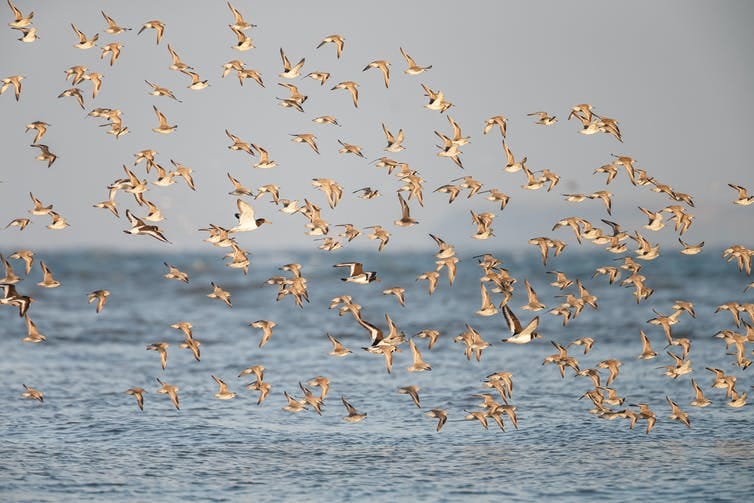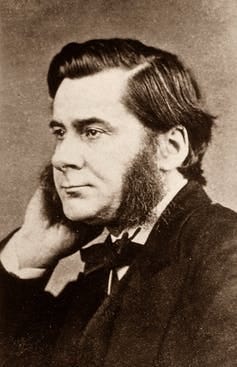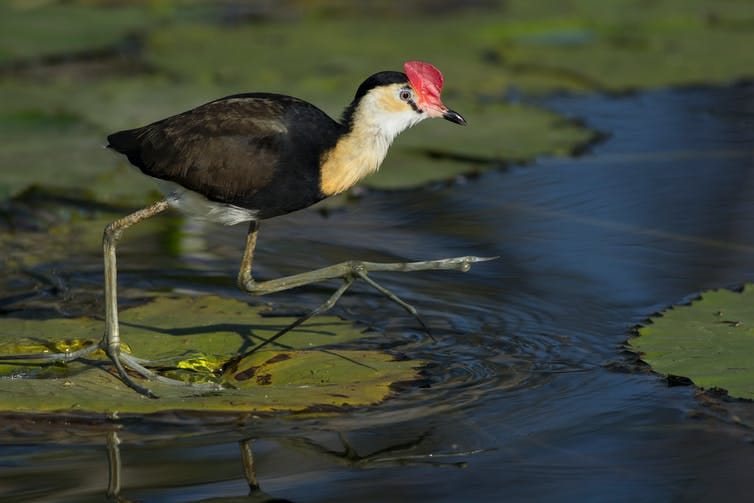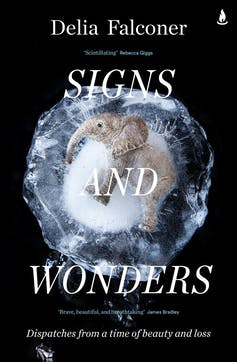On Birds — Feathered Messengers from Deep Time
By Delia Falconer, University of Technology Sydney.
When I experienced a great loss in in my early forties — almost a year to the day after another — I went to see my mother in the family home. She wasn’t a hugger or giver of advice, so instead we fed the birds. As she had when I was a child, she stood behind me in the kitchen with her shoulder propped against the back door, passing slices of apple and small balls of minced meat into my hand.
Each bird, apart from the snatching kookaburras, was touchingly gentle in the way it took food from my fingers. The white cockatoos ate daintily, one-legged. The lorikeets jumped onto the sloping ramp on both feet, like eager parachutists, to quarrel over the apple and press the juice from the pulp with stubby tongues.
Lined up on the veranda rail, the magpies cocked their heads to observe me before accepting meat precisely in their blue-white beaks. They had a beautiful, carolling song, with a chorded quality in the falling registers. But the bright-eyed butcher birds had the most lovely song of all: a full-throated piping, which I’ve heard compared to the Queen of the Night’s aria in Mozart’s Magic Flute.
Over decades, a family of these little blue-grey birds, had come to stack their hooked meat-eaters’ beaks with mince, which they flew to deliver to young somewhere in our neighbour’s garden, though we had never bothered to try to work out where they lived. This afternoon, when my mother and I opened the door, they landed by our side as they always had, having spotted us from their watching places. For a brief moment, surrounded by these vital creatures, I felt as if I might still want to be alive.
https://youtu.be/NGzasKOtjXI
Small agents
Birds have always been small agents charged with carrying the burden of our feelings simply by following the logic of their own existence. The Irish imagined puffins as the souls of priests. The ancient Romans released an eagle when an emperor died in the belief it would “conduct his soul aloft”. In the Abrahamic religions, doves are given powers of revelation. We have even been inclined, right up until the present, to imagine birds as the souls of our recently departed returned to us, if only for a moment.
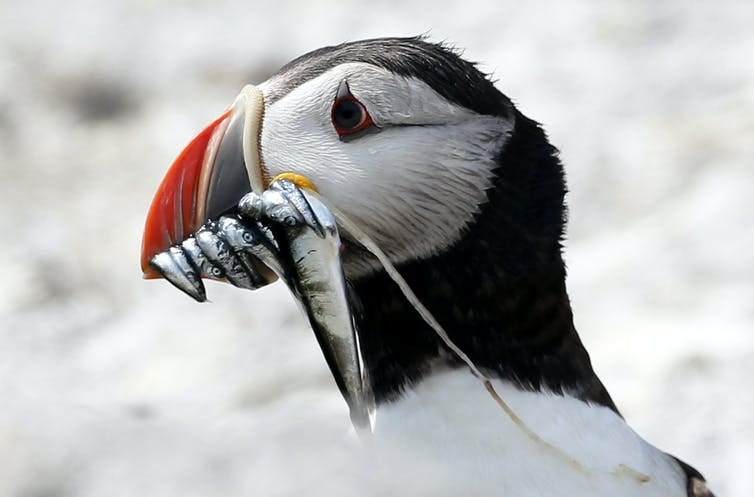
Even without being recruited into such labour, birds touch on our lives in small but significant ways. Once, in the botanical gardens of Melbourne, a boyfriend laughed until he almost cried at the mechanical, eager hopping of the tiny fairy wrens, a fact that only made me like him more. A friend tells the story of her uncle who ordered quail for the first time at a restaurant and cried when he saw it on his plate. “She had a raven’s heart, small and obdurate,” American author Don DeLillo writes of a nun in Underworld; it is my favourite description in any novel.
In Japan, where my partner and I tried to ease our sadness, the calls of crows were ubiquitous in every town. Like the low sounds of its deer, they had a subdued, almost exhausted quality, as hollow as the bells that are rattled to call the oldest spirits to its Shinto temples.
In 1975, when his first wife left him, Masahise Fukase began to photograph these birds, which he had seen from the window of a train. He would keep taking their pictures – on a hilltop tori at dusk, grouped on the budding branches of a bare tree, in flying silhouette – for ten years. Ravens would become one of the most famous books of modern photography, hailed as a “masterpiece of mourning”. While some people see the birds in his photos as symbols of loneliness I see them as embodiments of pure intention. “I work and photograph to stop everything,” Fukase said. As if fulfilling a prophecy, he would spend the last two decades of his life in a coma, after falling down the stairs at his favourite bar. https://www.youtube.com/embed/xZrjpWbdyiw?wmode=transparent&start=0
Yet for all our emotional investment in them, we’ve never treated birds particularly well. To train a falcon in Qatar, owners sew the young bird’s eyes shut, unstitching and then restitching them for longer intervals, until it is entirely dependent on its keeper. In Asia the appetite for caged songbirds is so great that their calls are disappearing from its forests. Our careless acceptance that these extraordinary creatures are subject to our will is perhaps as damning as any direct mistreatment of them. This is symbolised for me by that fact that, in North America, owners of long pipelines add a putrid odorant to the natural gas they carry so that turkey vultures, circling over the deathly smell, will alert them to methane leaks.
We are currently draining marshes globally three times faster than we are clearing forests. Migratory Red Knots fly 15,000 kilometres per year between Australia and their breeding grounds in the Arctic Tundra, but they’re declining because of the industrial development of the Yellow Sea’s tidal mudflats, where they stop to feed and rest. One of the details that most haunted me in the reports of Australia’s mega-fires was the fact that many birds that survived the radiant heat would die of smoke inhalation because the continuous one-way airflow of their breathing systems and air sacs meant they couldn’t cough to clear their lungs.
When we first moved into my childhood home, wattlebirds fed in the grevilleas, calling from the rockery with voices that sounded, as a poet once said to me, like the cork being pulled from a bottle of champagne. While their long forms ending in a slim, curved beak seemed the embodiment of alertness, they were the birds our cat caught most often. To see one, rescued but internally injured, vomit up its honey and grow limp was one of my first intimations as a child of the world’s evils. Unable to bear the thought of their sleek, streaky bodies in the bare earth, my mother would bury them wrapped in tea towels. But it was the 70s and no one thought to keep the cat inside.
As my mother entered her nineties, her life contracted around her birds. Although experts were now advising that the lack of calcium could soften chicks’ bones, I continued, against my conscience, to put through her weekly grocery order, which contained as much bird mince as food for herself. She had stopped feeding the cockatoos, which had chewed her windowsills and the struts of the back door, but when they heard us in the kitchen they would still plaster their chests like great white flowers against the window or poke their heads through the large holes they’d made over the years in the door’s wire fly screen.
But it was only the butcher birds that ever entered through these gaps to wait for her by the sink, feathers fluffed calmly. Once or twice, one would come and find her in the dining room and quietly walk back ahead of her to be fed. When I came with the children, she would press food into their hands as she stood behind them at the door, leaning against the kitchen counter for support. So she continued to be one of the estimated 30 to 60% of Australian households that fed wild birds, a statistic that suggests that we need them far more than they need us.
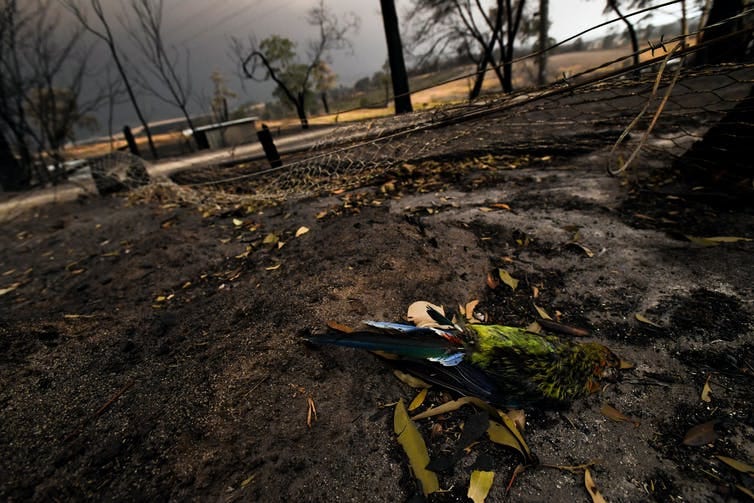
Survivors
Scientists began to think in the 19th century that birds might have evolved from dinosaurs, when the 150-million- year-old fossil skeleton of Archaeopteryx — which we now know was capable of short bursts of active flight — turned up in a German quarry.
The Victorian biologist Thomas Henry Huxley observed the bony-tailed, feathered fossil’s striking resemblance to small dinosaurs like Compsognathus and proposed that it was a transitional form between flightless reptiles and birds. Huxley’s theory fell out of favour until the last decades of the 20th century, when a new generation of palaeontologists returned to the similarities between the metabolisms and bird-like structures of dinosaur fossils and birds, and there is now a consensus that birds are avian dinosaurs. That the birds with which we share our lives are the descendants of the hollow-tailed, meat-eating theropods is a true wonder that never fails to thrill me.
Birds, like us, are survivors. They escaped the Cretaceous-Paleogene (or K-Pg) mass extinction event 65 million years ago: the fifth and last great dying in the history of our planet, until the Sixth Extinction taking place around us now.
Scientists were able to work out, from unusually high deposits of rare iridium (which mostly comes from outer space) in the Earth’s crust that a ten-kilometre-wide asteroid hitting the area that is now Mexico’s Yucatán Peninsula had killed off three quarters of the world’s living creatures by causing forest fires and then a freezing “nuclear winter,” which inhibited photosynthesis and rapidly acidified the oceans. Its blast was thousands of times more powerful than the combined force of all the nuclear weapons in the world today. The dust and debris it dispersed into the atmosphere eventually settled into a thin grey band of iridium-rich clay, which came to be called the K-Pg boundary and, above it, no trace of a non-avian dinosaur can be found.
In historical ironies whose obviousness would shame a novelist, it was geophysicists looking for petroleum in the 1970s who would discover the existence of the Chicxulub crater. Walter Alvarez, who discovered the “iridium anomaly”, was the son of physicist Luis Alvarez, a designer of America’s nuclear bombs, with whom he posited the asteroid strike theory; Alvarez senior had followed in a plane behind the Enola Gay to measure the blast effect as it dropped “Little Boy” on Hiroshima.
The ground-dwelling, beaked avian dinosaurs were able to scratch out a life for themselves in the ferny “disaster flora” that replaced the obliterated forests; their intelligence, their feathery insulation, their ability to feed on the destroyed forests’ seeds, and to digest the “hard, persistent little morsels” as one writer puts it, would help them to survive, and later flourish.
More incredibly, these dinosaurs were already recognisably bird-like, inside and out; capable of at least short horizontal flight like quails, the parts of their brains that controlled sight, flight and high-level memory as expanded as those of modern birds’, while our early mammal ancestors — small, nocturnal, insectivorous, shrew-like mammals — were hiding in clefts and caves.
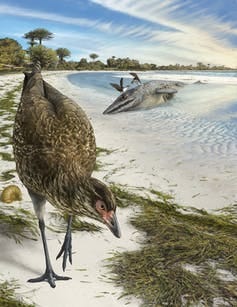
It is now thought that the world’s oldest modern bird, Asteriornis maastrichtensis, could probably fly and was combing the shallow beaches of today’s Belgium, in the way of modern long-legged shore birds, 700,000 years before the K-Pg mass extinction.
Because of a wealth of new fossil evidence in China, we now also know that feathers are far more ancient than we once thought; they didn’t evolve with birds 150 million years ago but are instead probably as old as dinosaurs themselves. In fact, many of the dinosaurs that we have been trained to think of as scaly, were at least partially feathered, including the fearsome Tyrannosaurus Rex, which may have used its primitive feathers, like a peacock, for display.
Powerful electron microscopes have allowed scientists to determine that the long filaments covering 150-million-year-old Sinosauropteryx, the first feathered non-avian dinosaur discovered, in China, in 1996, were “proto-feathers”; and even, looking at the melanosomes inside them, that they were ginger, running in a “Mohican” pattern down its back and ending in a stripey white-and-ginger tail. Similar examination of the melanosomes of another Jurassic-era theropod found that it had a grey-and-dark plumage on its body, long white and black-spangled forelimbs, and a reddish-brown, fluffy crown.
Scientists are puzzled about what dinosaurs’ feathers, which developed before the capacity of feathered flight, were “for”, but I don’t really care: the fact of them is startling enough, along with the imaginative readjustments we have to make in seeing the fearsome creatures of paleoart that we grew up with, locked in orgasmic conflict, as softly plumaged. Did their young call for them with the same open-mouthed yearning as baby birds, I wonder? Did they possess their own sense of beauty? If we imagine dinosaurs as being less alien and fluffier, does it make our own era’s potential annihilation seem more real?
Read more: Meet the prehistoric eagle that ruled Australian forests 25 million years ago
Emissaries
Over the last century folkorists and psychoanalysts have kept trying to account for birds’ deep hold over our imaginations; as agents of death, prophets, ferriers of souls, omens, and symbols of renewal and productivity. Some attribute it to the power of flight and their ability to inhabit the heavens, others to the way eggs embody transformation. But could it be that the vestigial shrew-like part of ourselves has always recognised them instinctively as the emissaries of a deep past, much older than we are? “We float on a bubble of space-time,” writes author Verlyn Klinkenberg, “on the surface of an ocean of deep time”.
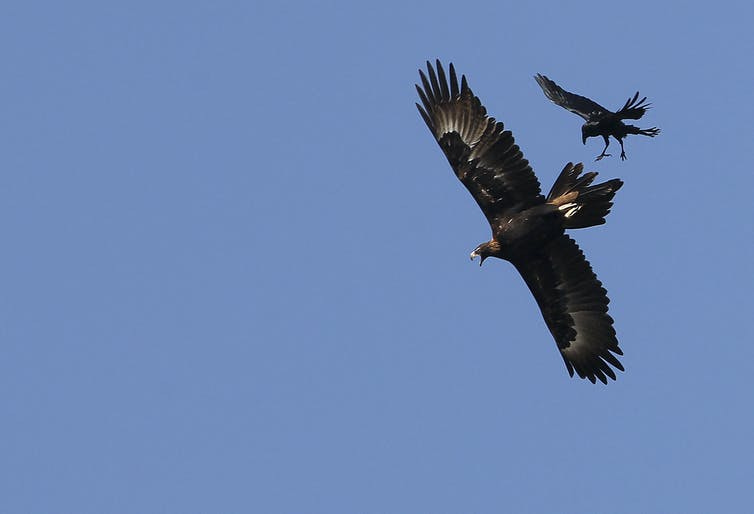
Recently, this deep past has begun to reassert itself as, even during coronavirus lockdowns, burned fossil fuels continue to release carbon dioxide into the atmosphere, bringing its concentration in the air to levels not seen since the Pliocene three million years ago when the seas were 30 metres higher. To try to help us understand the literal profundity of this moment in the history of the earth, writers have been looking increasingly below its surface, far beyond the human realm, to its deepest, billions-of-years-old strata.
In his astonishing Underland, English writer Robert Macfarlane travels physically far underground into caves, mines, and nuclear waste bunkers, to revive our ancient sense of awe as forces and substances once thought safely confined there begin to exert themselves above ground, but also to convey the enormity of the long shadow we will cast into the future of a planet that has already seen periods of great transformation.
In Timefulness, geologist Marcia Bjornerud argues that understanding the Earth through her discipline’s vastly expanded time-scales can help us avoid the almost unthinkably grave consequences of our actions. We live in an era of time denial, she writes, while navigating towards the future with conceptions of the long patterns of planetary history as primitive as a 14th-century world map. And yet, she writes, “as a daughter, mother, and widow, I struggle like everyone else to look Time honestly in the face.”
Yet here, I think, all around us on the surface of the planet, are our vivacious and inscrutable companions, feathered messengers from deep time, who still tell their own story of complex change.
What lives and dies
At a writer’s festival in northern New South Wales, I remember, a magpie lark landed between the chair and speaker on stage to let forth a cascade of liquid notes, “as if, to say,” a droll friend sitting next to me said, “I too have something to contribute!” while I found myself wondering, yet again, how something with such a small heart could be so alive.
To think about dinosaurs, as evolutionary biologist Steven Brusatte writes, is to confront the question of what lives and what dies. To think that dinosaurs were far more complex than we imagined, Klinkenberg muses, interrupts the chain of consequence we’ve been carrying in our heads, which assumes that deep time’s purpose was to lead to us as the end point of evolution. The history of feathers and wings, in which the power of flight appears to have been discovered and lost at least three times, shows that evolution is not a tree, but a clumped bush. And yet, Klinkenberg writes, “Because we come after, it’s easy to suppose we must be the purpose of what came before.”
The same could be said of mothers. When the time came to choose the photographs for my mother’s funeral, the images of her as a child in Mexico and Canada seemed as unreal as dispatches from the moon. The photographs of our mothers as young girls are so affecting a friend wrote to me, because they show them living lives that were whole without us. Now my own children turn their heads away from pictures of me as a girl, because, they say, “You don’t look like you.” And yet, if our minds struggle to encompass the deep time of our mothers, I think, how can they hope to stretch across aeons?
On my last visit to my mother, I left her on her front step throwing meat to the two magpies which had learned to come around from the backyard, away from the other birds, and would follow her on stilted legs around the garden. When she pressed her emergency pendant the next morning, I missed her call; it was my partner, hearing her faint answers, who called the ambulance. Unconscious in the hospital, she died having never known that she had left her home. When I stopped back at the house afterwards, one of the butcher birds, which I had never seen around the front, was on the windowsill of her dark bedroom, break pressed against the glass, looking for her.
This is an extract from Signs and Wonders: Dispatches from a time of beauty and loss by Delia Falconer, published by Simon and Schuster.
Delia Falconer, Senior Lecturer, Creative Writing, UTS, University of Technology Sydney
This article is republished from The Conversation under a Creative Commons license. Read the original article.




